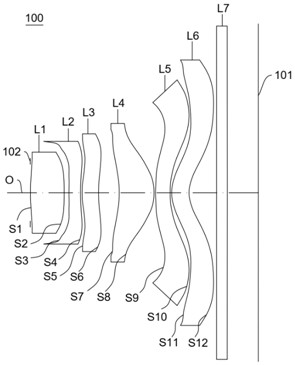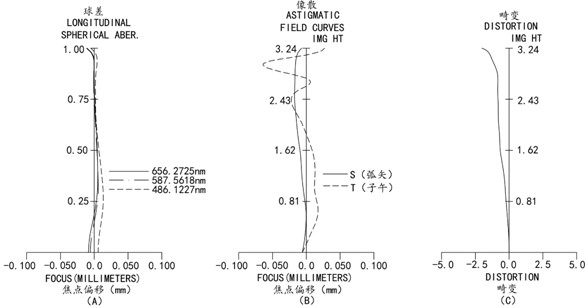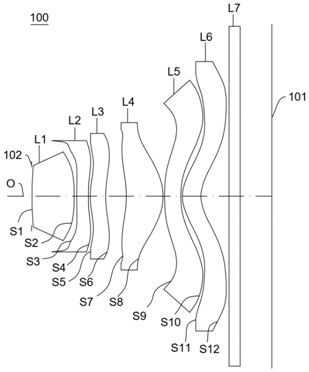Optical lens, camera module and electronic equipment
An optical lens and lens technology, applied in optics, optical components, instruments, etc., can solve problems such as difficult to meet the imaging quality of optical lenses at the same time, and achieve the effect of miniaturization design, reduced hole size, and high imaging quality requirements
- Summary
- Abstract
- Description
- Claims
- Application Information
AI Technical Summary
Problems solved by technology
Method used
Image
Examples
no. 1 example
[0071] The structural diagram of the optical lens 100 disclosed in the first embodiment of the present application is as follows figure 1 As shown, the optical lens 100 includes a first lens L1, a second lens L2, a diaphragm 102, a third lens L3, a fourth lens L4, a fifth lens L5, a first lens L1, and a second lens L1 arranged in sequence from the object side to the image side along the optical axis O. Six lenses L6 and filter L7. For the materials of the first lens L1 , the second lens L2 , the third lens L3 , the fourth lens L4 , the fifth lens L5 and the sixth lens L6 , please refer to the above-mentioned detailed description, and will not repeat them here.
[0072] Further, the first lens L1 has a positive refractive power, the second lens L2 has a negative refractive power, the third lens L3 has a positive refractive power, the fourth lens L4 has a positive refractive power, the fifth lens L5 has a negative refractive power, and the sixth lens L3 has a positive refractive...
no. 2 example
[0086] Please refer to image 3 , image 3 It is a schematic structural diagram of the optical lens 100 according to the second embodiment of the present application. The optical lens 100 includes a first lens L1, a second lens L2, a diaphragm 102, a third lens L3, a fourth lens L4, a fifth lens L5, and a sixth lens L6 arranged in sequence from the object side to the image side along the optical axis O and filter L7. For the materials of the first lens L1 , the second lens L2 , the third lens L3 , the fourth lens L4 , the fifth lens L5 and the sixth lens L6 , please refer to the above-mentioned detailed description, and will not repeat them here.
[0087] Further, in the second embodiment, the difference between the refractive power of each lens and the refractive power of each lens in the first embodiment is that the sixth lens L6 has a positive refractive power. And the object side of each lens of the optical lens 100 in the second embodiment, image side at the near optic...
no. 3 example
[0096] Please refer to Figure 5 , Figure 5 It is a schematic structural diagram of the optical lens 100 according to the third embodiment of the present application. The optical lens 100 includes a first lens L1, a second lens L2, a diaphragm 102, a third lens L3, a fourth lens L4, a fifth lens L5, and a sixth lens L6 arranged in sequence from the object side to the image side along the optical axis O and filter L7. For the materials of the first lens L1 , the second lens L2 , the third lens L3 , the fourth lens L4 , the fifth lens L5 and the sixth lens L6 , please refer to the above-mentioned detailed description, and will not repeat them here.
[0097] Further, in the third embodiment, the difference between the refractive power of each lens and the refractive power of each lens in the first embodiment is that the sixth lens L6 has a positive refractive power. At the same time, in the third embodiment, the difference between the surface type of each lens and the surface...
PUM
 Login to View More
Login to View More Abstract
Description
Claims
Application Information
 Login to View More
Login to View More - R&D Engineer
- R&D Manager
- IP Professional
- Industry Leading Data Capabilities
- Powerful AI technology
- Patent DNA Extraction
Browse by: Latest US Patents, China's latest patents, Technical Efficacy Thesaurus, Application Domain, Technology Topic, Popular Technical Reports.
© 2024 PatSnap. All rights reserved.Legal|Privacy policy|Modern Slavery Act Transparency Statement|Sitemap|About US| Contact US: help@patsnap.com










